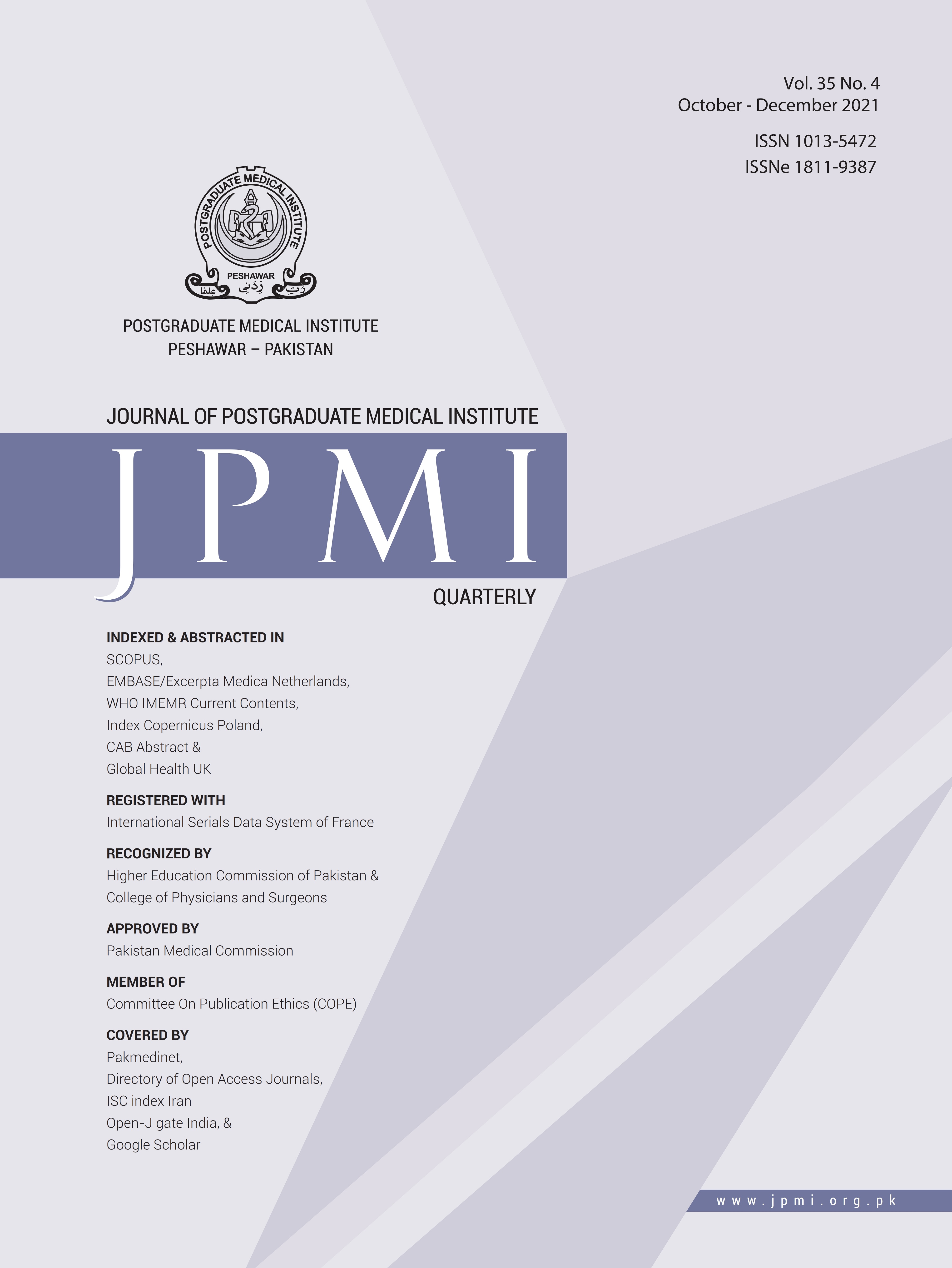COMPARISON OF EFFICACY OF BOTULINUM INJECTION WITH SURGICAL RELEASE IN CEREBRAL PALSY CHILDREN WITH FOOT EQUINUS
Main Article Content
Abstract
Objective: To compare the efficacy of surgical release and Botulinum Toxin injections for treating foot equinus in Cerebral Palsy (CP) patients.
Methodology: This Quasi-experimental study was conducted in the Orthopedic Department, Khyber Teaching Hospital (KTH) Peshawar-Pakistan. The study enrolled 60 patients from 1st March 2018 to 1st June 2019 via non-probability consecutive sampling. All diagnosed cases of CP with equinus foot of either gender and age between 4-18 years with no previous surgery or botulinum injections and no joint deformity were included; while all patients with myasthenia gravis, neuromuscular junction disease, use of aminoglycoside, and those with discontinued physiotherapy were excluded. The patients were distributed into two equal groups, group A (botulinum group) and group B (surgery group). The outcome of the interventions in each group was measured based on improvement in Gross Motor Function Measure-66 (GMFM-66). Data was analysed using SPSS v.21.0, descriptive and analytical analysis was conducted where needed.
Results: The mean age of patients was 11.47±4.01 years with male to female ratio of 1.22:1. The right and left foot distribution among the patients was 31 (52%) and 29 (48%) respectively. Botulinum type A (BTX-A) injection resulted in improvement of GMFM-66 score in 27 (90%) patients in group A while the surgical release was effective in 20 (66.7%) patients in group B in terms of improvement in GMFM-66 score.
Conclusion: The study concluded that Botulinum Toxin has much better effectiveness as compared to surgical release in treatment of foot equinus among CP patients.
Article Details
Work published in JPMI is licensed under a
Creative Commons Attribution-NonCommercial 2.0 Generic License.
Authors are permitted and encouraged to post their work online (e.g., in institutional repositories or on their website) prior to and during the submission process, as it can lead to productive exchanges, as well as earlier and greater citation of published work.
References
Unlu E, Cevikol A, Bal B, Gonen E, Celik O, Kose G. Multilevel botulinum toxin type a as a treatment for spasticity in children with cerebral palsy: A retro¬spective study. Clinics. 2010; 65:613- 9.
Camargo CHF, Teive HA, Zonta M, Silva GC, Oliveira MR, Roriz MM, et al. Bot¬ulinum toxin type A in the treatment of lower-limb spasticity in children with cerebral palsy. Arquivos de neu¬ro-psiquiatria. 2009; 67: 62-8.
Shore BJ, White N, Kerr Graham H. Sur¬gical correction of equinus deformity in children with cerebral palsy: A sys¬tematic review. J Child Orthop. 2010; 4(4):277-90.
Joo SY, Knowtharapu DN, Rogers KJ, Holmes Jr L, Miller F. Recurrence after surgery for equinus foot deformity in children with cerebral palsy: Assess¬ment of predisposing factors for recur¬rence in a long-term follow-up study. J Child Orthop. 2011; 5(4):289-96.
Young JS, N. KD, J. RK, Jr HL, Freeman M. Recurrence after surgery for equinus foot deformity in children with cere¬bral palsy: assessment of predisposing factors for recurrence in a long-term follow-up study. J Child Orthop. 2011; 5(4):289-96.
Botox Toxins. [online] 2021. [citied 2021 October 18]. Available from: URL: https://en.wikipedia.org/wiki/Botuli¬num_toxin.
Nigam PK, Nigam A. Botulinum toxin. Indian J Dermatol. 2010; 55(1):8.
Strobl W, Theologis T, Brunner R, Kocer S, Viehweger E, Pascual-Pascual I, et al. Best clinical practice in botulinum toxin treatment for children with cerebral pal¬sy. Toxins. 2015; 7(5):1629-48.
Sätilä H, Huhtala H. Botulinum toxin type A injections for treatment of spastic equinus in cerebral palsy: A secondary analysis of factors predictive of favor¬able response. Am J Phys Med Rehabil. 2010; 89(11):865-72.
Park ES, Rha D-w, Yoo JK, Kim SM, Chang WH, Song SH. Short-term effects of combined serial casting and botuli¬num toxin injection for spastic equinus in ambulatory children with cerebral palsy. Yonsei Med J. 2010; 51(4):579- 84.
Scholtes VAB. The effectiveness of multilevel botulinum toxin type A and comprehensive rehabilitation in children with cerebral palsy [dissertation]. Am¬sterdam: Vrije Uni.; 2007.
Hambleton P, Moore A. Botulinum neu¬rotoxins: Origin, structure, molecular actions and antibodies. Handbook of botulinum toxin treatment. London: Blackwell Science; 1995.
Koman LA, Mooney III JF, Smith BP, Walker F, Leon JM, Group BS. Botuli¬num toxin type A neuromuscular block¬ade in the treatment of lower extremity spasticity in cerebral palsy: A random-ized, double-blind, placebo-controlled trial. J Pediatr Orthop. 2000; 20(1):108.
Bleck EE. Orthopaedic management in cerebral palsy. Clin Dev Med. 1987.
Gage J. Gait Analysis in Cerebral Palsy. Cambridge Uni Press; 1991.
Brin MF, Fahn S, Moskowitz C, Friedman A, Shale HM, Greene PE, et al. Local¬ized injections of botulinum toxin for the treatment of focal dystonia and hemifa¬cial spasm. Movement disorders. J Mov Disord. 1987; 2(4):237-54.
Jankovic J, Schwartz KS. Longitudinal experience with botulinum toxin injec¬tions for treatment of blepharospasm and cervical dystonia. Neurol. 1993; 43(4):834-6.
Campbell SK. Quantifying the effects of interventions for movement disorders resulting from cerebral palsy. J Child Neurol. 1996; 11 Suppl 1:S61-70.
Russell DJ, Rosenbaum PL, Cadman DT, Gowland C, Hardy S, Jarvis S. The gross motor function measure: a means to evaluate the effects of physical therapy. Dev Med Child Neurol. 1989; 31(3):341-52.
Wright FV, Sheil EM, Drake JM, Wedge JH, Naumann S. Evaluation of selective dorsal rhizotomy for the reduction of spasticity in cerebral palsy: A random¬ized controlled trial. Dev Med Child Neu¬rol. 1998; 40(4):239-47.
Multani I, Manji J. Botulinum Toxin in the Management of Children with Ce¬rebral Palsy. Paediatr Drugs. 2019; 21(4):261-81.
Rattey TE, Leahey L, Hyndman J, Brown DC, Gross M. Recurrence after Achilles tendon lengthening in cerebral palsy. J Pediatr Orthop. 1993;13(2):184-7.
Palazón-García R, Benavente-Valde¬peñas AM. Botulinum Toxin: From Poi¬son to Possible Treatment for Spastic¬ity in Spinal Cord Injury. Int J Mol Sci. 2021; 22(9).
Eames NW, Baker R, Hill N, Graham K, Taylor T, Cosgrove A. The effect of botulinum toxin A on gastrocnemius length: magnitude and duration of re¬sponse. Dev Med Child Neurol. 1999; 41(4):226-32.


